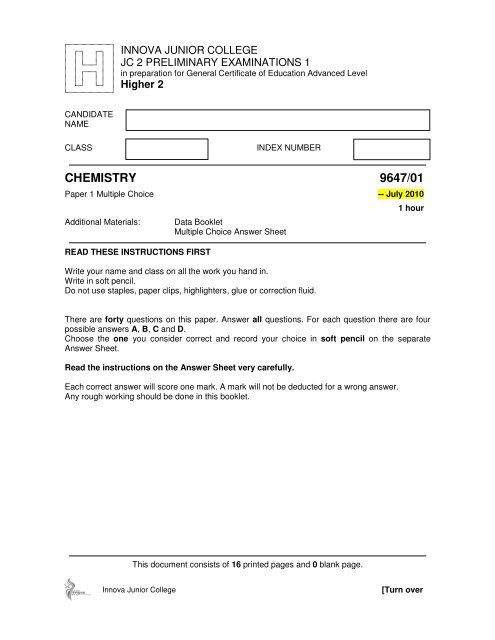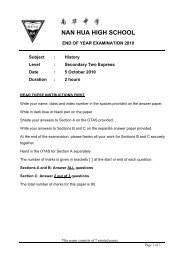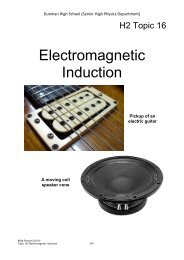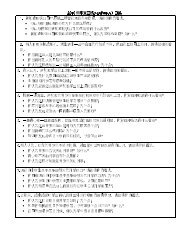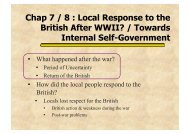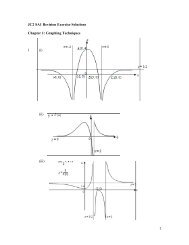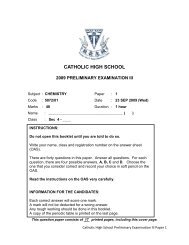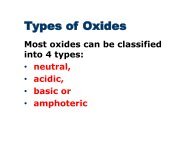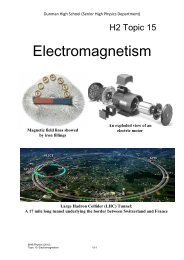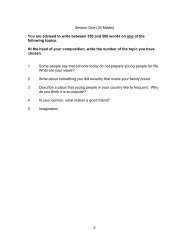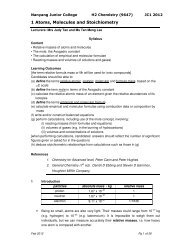CHEMISTRY 9647/01 - ASKnLearn
CHEMISTRY 9647/01 - ASKnLearn
CHEMISTRY 9647/01 - ASKnLearn
Create successful ePaper yourself
Turn your PDF publications into a flip-book with our unique Google optimized e-Paper software.
1<br />
INNOVA JUNIOR COLLEGE<br />
JC 2 PRELIMINARY EXAMINATIONS 1<br />
in preparation for General Certificate of Education Advanced Level<br />
Higher 2<br />
CANDIDATE<br />
NAME<br />
CLASS<br />
INDEX NUMBER<br />
<strong>CHEMISTRY</strong><br />
Paper 1 Multiple Choice<br />
Additional Materials:<br />
Data Booklet<br />
Multiple Choice Answer Sheet<br />
<strong>9647</strong>/<strong>01</strong><br />
-- July 2<strong>01</strong>0<br />
1 hour<br />
READ THESE INSTRUCTIONS FIRST<br />
Write your name and class on all the work you hand in.<br />
Write in soft pencil.<br />
Do not use staples, paper clips, highlighters, glue or correction fluid.<br />
There are forty questions on this paper. Answer all questions. For each question there are four<br />
possible answers A, B, C and D.<br />
Choose the one you consider correct and record your choice in soft pencil on the separate<br />
Answer Sheet.<br />
Read the instructions on the Answer Sheet very carefully.<br />
Each correct answer will score one mark. A mark will not be deducted for a wrong answer.<br />
Any rough working should be done in this booklet.<br />
This document consists of 16 printed pages and 0 blank page.<br />
Innova Junior College<br />
[Turn over
2<br />
Section A<br />
For each question there are four possible answers, A, B, C, and D. Choose the one you consider<br />
to be correct.<br />
1 On heating, 0.02 moles of element S reacts with 0.<strong>01</strong>5 moles of oxygen gas. What is the<br />
empirical formula of the oxide of S<br />
A S 2 O 3 C S 2 O 5<br />
B SO 3 D S 2 O<br />
2 Group I and Group II ionic hydrides react with water according to the following reaction:<br />
H – + H 2 O → OH – + H 2<br />
In an experiment, 1 g of a sample of ionic hydride was dissolved in excess water. The<br />
resulting solution required 24.0 cm 3 of a 2.0 mol dm -3 of HCl solution for complete<br />
neutralization. What is the formula of the hydride used<br />
A CaH 2 C LiH<br />
B MgH 2 D NaH<br />
3 Which of the following is the correct electronic configuration of the hypothetical ion 50 +<br />
25 T <br />
A 1s 2 2s 2 2p 6 3s 2 3p 6 3d 6<br />
B 1s 2 2s 2 2p 6 3s 2 3p 6 4s 2 3d 4<br />
C 1s 2 2s 2 2p 6 3s 2 3p 6 3d 4 4s 2<br />
D 1s 2 2s 2 2p 6 3s 2 3p 6 3d 5 4s 1<br />
4 Which of the following ions will be deflected the most when passed through an electric<br />
field<br />
A 24 2+<br />
12 Mg C 27<br />
13 Al3+<br />
B 14 N 3-<br />
D 16 O 2-<br />
7 8<br />
5 In which of the following groups are all the species of the same shape<br />
A<br />
NH 3 , HCHO<br />
B H 2 O 2 , N 2 H 4<br />
C CO 2 , I 3<br />
–<br />
D CH 4 , XeCl 4<br />
PRELIM 1 © INNOVA <strong>9647</strong>/<strong>01</strong>/2<strong>01</strong>0 [Turn over
3<br />
6 Solid iodine, I 2 (s), is known to sublime at room temperature to give a violet vapour. What<br />
does this suggest about the main intermolecular bonding in I 2 (s) to be<br />
A<br />
B<br />
C<br />
D<br />
Hydrogen bonding<br />
Covalent bonding<br />
van der Waals’ forces<br />
Ionic bonding<br />
7 An ideal gas will obey the PV = nRT equation. 1 mole of gas U occupies a volume of<br />
12.3 dm 3 at 300 K and 2.0 atm. Another mole of gas V occupies a volume of 22.4 dm 3 at<br />
the same temperature and pressure. Which of the following best describes this<br />
phenomenon<br />
A Gas U is He while gas V is NH 3 .<br />
B Gas U is CO 2 while gas V is CH 4 .<br />
C<br />
D<br />
Gases U and V are behaving ideally.<br />
Gases U and V experience significant intermolecular forces of attraction between<br />
their molecules.<br />
8 Ammonium hydrogen sulfide dissociates as follows:<br />
NH 4 HS (s) H 2 S (g) + NH 3 (g) ∆H > 0<br />
When an excess of NH 4 HS (s) is placed in an enclosed vessel at 300 K, it dissociates until<br />
the total pressure is 0.66 atm. Which of the following statements is correct about the<br />
above system<br />
A<br />
B<br />
C<br />
By Le Chatelier’s principle, addition of NH 4 HS would cause the equilibrium position<br />
to shift right.<br />
An increase in temperature will cause the percentage dissociation of NH 4 HS to<br />
decrease.<br />
When the system is compressed, the value of K p will decrease.<br />
D The K p of the system is 0.109 atm 2 .<br />
PRELIM 1 © INNOVA <strong>9647</strong>/<strong>01</strong>/2<strong>01</strong>0 [Turn over
4<br />
9 The graph below shows the results of an investigation of the initial rate of reaction of a<br />
particular substrate by its enzyme. In the experiments, only the concentration of the<br />
substrate was varied, keeping the concentration of the enzyme constant.<br />
Which of the following is true about the graph above<br />
A<br />
B<br />
C<br />
D<br />
At V max , the catalytic enzyme reaction stops.<br />
At very high [substrate], the rate of reaction becomes dependent on [substrate].<br />
At low [substrate], the reaction is first order with respect to [substrate].<br />
K m is the Michaelis constant and is defined as the concentration of substrate needed<br />
to achieve the maximal rate of reaction.<br />
10 For the elimination of HCl from C 2 H 4 Cl 2 ,<br />
C 2 H 4 Cl 2 (g) → C 2 H 4 (g) + Cl 2 (g)<br />
the standard thermodynamic values (at 25 ° C) are<br />
∆H θ +83.5 kJ mol -1<br />
∆S θ +83.0 J mol -1 K -1<br />
Determine the lowest temperature at which the above reaction will become feasible.<br />
A<br />
B<br />
C<br />
D<br />
Greater than 1006 K<br />
Greater than 1.006 K<br />
Less than 1006 K<br />
Less than 1.006 K<br />
PRELIM 1 © INNOVA <strong>9647</strong>/<strong>01</strong>/2<strong>01</strong>0 [Turn over
5<br />
11 Phosphorus can react with chlorine to form phosphorus pentachloride and phosphorus<br />
trichloride. Some thermochemical data related to these elements are shown below:<br />
Enthalpy change of atomization of phosphorus +314 kJ mol -1<br />
Enthalpy change of formation of PCl 5 –500 kJ mol -1<br />
Bond energy of Cl 2 +244 kJ mol -1<br />
What is the mean P-Cl bond energy in PCl 5 <br />
A +85 kJ mol -1<br />
B +285 kJ mol -1<br />
C +424 kJ mol -1<br />
D +1424 kJ mol -1<br />
12 Values of ionic product for water at different temperatures are given below:<br />
Temperature/ ° C 0 25 100<br />
K w /mol 2 dm -6 1.1 x 10 -15 1.0 x 10 -14 5.1 x 10 -13<br />
What are the approximate values of the pH of pure water at 0 ° C, 25 ° C and 100 ° C<br />
0 ° C 25 ° C 100 ° C<br />
A 6.1 7.0 7.5<br />
B 7.0 7.0 7.0<br />
C 7.5 7.0 6.1<br />
D 15.0 14.0 12.3<br />
13 How much water must be added to 2.0 dm 3 of a solution of a strong acid of pH 2.0 in order<br />
to increase the pH to 3.0<br />
A 1.0 dm 3<br />
B 2.0 dm 3<br />
C 10.0 dm 3<br />
D 18.0 dm 3<br />
PRELIM 1 © INNOVA <strong>9647</strong>/<strong>01</strong>/2<strong>01</strong>0 [Turn over
6<br />
14 The standard electrode potential E θ for each of the three electrode reactions in aqueous<br />
solutions, is given below.<br />
Electrode reaction E θ /V<br />
2CO 2 + 2e C 2 O 4<br />
2–<br />
–0.49<br />
Fe 3+ + e Fe 2+ +0.77<br />
MnO 4 – + 8H + + 5e Mn 2+ + 4H 2 O +1.52<br />
How many moles of MnO 4 – will react with 1 mole of iron(II) ethanedioate in acid solution<br />
A 1<br />
5<br />
B 2<br />
5<br />
C 3<br />
5<br />
D 5<br />
3<br />
15 The structure of Vitamin A is given below.<br />
Vitamin A can react with hydrogen gas in the presence of nickel catalyst at high<br />
temperature and high pressure to give Compound W. How many chiral centres do the<br />
molecules of Vitamin A and Compound W have<br />
Vitamin A<br />
Compound W<br />
A 0 2<br />
B 0 4<br />
C 1 2<br />
D 1 4<br />
PRELIM 1 © INNOVA <strong>9647</strong>/<strong>01</strong>/2<strong>01</strong>0 [Turn over
7<br />
16 2,4-dichlorophenol is used as a starting material in the preparation of a weed killer,<br />
2,4-D. It can react with 2-chloroacetyl chloride under suitable conditions to obtain two<br />
different products.<br />
Cl<br />
Cl<br />
OH<br />
Cl<br />
2,4-dichlorophenol<br />
+<br />
ClCH 2 COCl<br />
reaction I<br />
reaction II<br />
Cl<br />
Cl<br />
product 1<br />
OCH 2 COCl<br />
OCOCH 2 Cl<br />
What is the mechanism of reaction I and reaction II<br />
Cl<br />
product 2<br />
reaction I<br />
reaction II<br />
A Elimination Electrophilic substitution<br />
B Electrophilic substitution Condensation<br />
C Nucleophilic substitution Electrophilic substitution<br />
D Nucleophilic substitution Nucleophilic substitution<br />
17 Experiments are carried out on three compounds X, Y, Z.<br />
A sample of 0.<strong>01</strong> mol of each compound is boiled under reflux with 50 cm 3 of 1 mol dm -3<br />
NaOH (excess) until hydrolysis is complete and any ammonia produced is expelled from<br />
solution. The excess NaOH is titrated in each case and found to require 20 cm 3 , 30 cm 3<br />
and 40 cm 3 of 1 mol dm -3 HCl for neutralization.<br />
Which sequence of compounds matches these results<br />
20 cm 3 30 cm 3 40 cm 3<br />
A X Y Z<br />
B X Z Y<br />
C Y Z X<br />
D Z Y X<br />
PRELIM 1 © INNOVA <strong>9647</strong>/<strong>01</strong>/2<strong>01</strong>0 [Turn over
8<br />
18 Which pair of reactions could have the same common intermediate<br />
L CH 3 CH 2 CH 3 Intermediate (CH 3 ) 2 CHCN<br />
M CH 3 CH(OH)CH 3 Intermediate (CH 3 ) 2 C(OH)CN<br />
N CH 3 CH=CH 2 Intermediate CH 3 CH(NH 2 )CH 3<br />
O CH 3 CO 2 CH 2 CH 2 CH 3 Intermediate CH 3 CH 2 CH 2 Br<br />
A L and M C M and O<br />
B L and N D N and O<br />
19 Citric acid, which causes the sharp taste of lemon juice, has the following structure.<br />
Which of the following reacts completely with 1 mol of citric acid<br />
A 3 mol of PCl 5<br />
B 4 mol of HCl<br />
C 4 mol of Na<br />
D 4 mol of NaOH<br />
20 For which pair of compounds can alkaline aqueous iodine be used to distinguish between<br />
members of the pair<br />
A CH 3 COOH and CH 3 COOCH 3<br />
B CH 3 CHO and CH 3 COOH<br />
C CH 3 CHO and CH 3 CH(OH)CH 3<br />
D (CH 3 ) 3 COH and CH 3 CH 2 CH 2 OH<br />
21 Which pair of compounds would be formed in the reaction of ethene with aqueous<br />
bromine in the presence of aqueous sodium chloride<br />
A<br />
B<br />
C<br />
D<br />
CH 2 BrCH 2 OH and CH 2 ClCH 2 OH<br />
CH 2 BrCH 2 OH and CH 2 ClCH 2 Cl<br />
CH 2 BrCH 2 Cl and CH 2 ClCH 2 Cl<br />
CH 2 BrCH 2 Br and CH 2 BrCH 2 Cl<br />
PRELIM 1 © INNOVA <strong>9647</strong>/<strong>01</strong>/2<strong>01</strong>0 [Turn over
9<br />
22 Methylbenzene was reacted with chlorine in the presence of AlBr 3 catalyst. What organic<br />
product would be formed<br />
A<br />
C<br />
B CH 3<br />
Br<br />
D CH 3<br />
Br<br />
Cl<br />
PRELIM 1 © INNOVA <strong>9647</strong>/<strong>01</strong>/2<strong>01</strong>0 [Turn over
10<br />
23 A mixture containing three amino acids was placed in a solution of pH 3 and subjected to<br />
electrophoresis as follows :<br />
The structures of the three amino acids as well as their isoelectric points are shown below.<br />
H<br />
Amino acid<br />
H 3 C<br />
H 2 N<br />
C CH 3<br />
C<br />
COOH<br />
Glutamic acid (Glu) Glycine (Gly) Valine (Val)<br />
Isoelectric point 3.2 5.7 6.1<br />
H<br />
Which one of the following filter papers shows a possible result of the separation of the<br />
amino acid mixture at pH 3<br />
A<br />
B<br />
C<br />
D<br />
PRELIM 1 © INNOVA <strong>9647</strong>/<strong>01</strong>/2<strong>01</strong>0 [Turn over
11<br />
24 Which of the following compounds gives<br />
(i) fumes of HCl with PCl 5<br />
(ii) NH 3 when heated with NaOH (aq)<br />
A HOCH 2 CONH 2<br />
B HOCH 2 CH 2 NH 2<br />
C NH 2 CH 2 COOH<br />
D NH 2 CH 2 CONH 2<br />
25 An element from the third period (Na to S) is heated in chlorine. When the purified product<br />
is added to water, the resulting solution is found to be weakly acidic.<br />
Which of the following could be the element<br />
A Sodium C Aluminium<br />
B Silicon D Phosphorus<br />
26 Which of the following is a correct statement about transition metals<br />
A They are the only metals which form complex ions.<br />
B They are the only metals which give coloured ions in an aqueous solution.<br />
C They are the only metals which have more than one valency (oxidation state).<br />
D They are the only metals with a complete 4s orbital in their atoms.<br />
27 Use of the Data Booklet is relevant to this question.<br />
When heated strongly, PbCO 3 and ZnCO 3 decompose in the same way as CaCO 3 .<br />
What is the order of decomposition temperatures predicted for these three carbonates<br />
highest<br />
lowest<br />
A CaCO 3 > PbCO 3 > ZnCO 3<br />
B CaCO 3 > ZnCO 3 > PbCO 3<br />
C PbCO 3 > CaCO 3 > ZnCO 3<br />
D ZnCO 3 > CaCO 3 > PbCO 3<br />
28 Which property about the Group II element, strontium (or its compounds), is correct<br />
A<br />
B<br />
C<br />
D<br />
Strontium does not burn in air.<br />
Strontium does not react with steam.<br />
Strontium nitrate decomposes at a lower temperature than calcium nitrate.<br />
Strontium hydroxide is dehydrated to the oxide on being heated.<br />
PRELIM 1 © INNOVA <strong>9647</strong>/<strong>01</strong>/2<strong>01</strong>0 [Turn over
12<br />
29 Consider the following three reactions:<br />
Cl 2 (g) + 2H 2 O (l) + SO 2 (g) → 2HCl (aq) + H 2 SO 4 (aq)<br />
Cl 2 (g) + H 2 S (g) → 2HCl (aq) + S (s)<br />
SO 2 (g) + 2H 2 S (g) → 2H 2 O (l) + 3S (s)<br />
Which of the following shows the correct order of strength of the three reacting gases as<br />
reducing agents<br />
strongest<br />
weakest<br />
A Chlorine Hydrogen sulfide Sulfur dioxide<br />
B Chlorine Sulfur dioxide Hydrogen sulfide<br />
C Hydrogen sulfide Sulfur dioxide Chlorine<br />
D Sulfur dioxide Hydrogen sulfide Chlorine<br />
30 A pale blue precipitate is formed when drops of NH 3 (aq) are added to Cu(NO 3 ) 2 (aq).<br />
When an excess of NH 3 (aq) is added, this precipitate dissolves giving a deep blue<br />
solution.<br />
Which process is not present in the above reaction sequence<br />
A<br />
B<br />
C<br />
D<br />
Dative bond formation<br />
Formation of complex ion<br />
Precipitation of copper(II) hydroxide<br />
Reduction of Cu 2+ ions<br />
PRELIM 1 © INNOVA <strong>9647</strong>/<strong>01</strong>/2<strong>01</strong>0 [Turn over
13<br />
Section B<br />
For each of the questions in this section, one or more of the three numbered statements 1 to 3<br />
may be correct.<br />
Decide whether each of the statements is or is not correct (you may find it helpful to put a tick<br />
against the statements that you consider to be correct).<br />
The responses A to D should be selected on the basis of<br />
A B C D<br />
1, 2 and 3 are correct 1 and 2 only are<br />
correct<br />
2 and 3 only are<br />
correct<br />
1 only is correct.<br />
No other combination of statements is used as a correct response.<br />
31 An alkene, C n H 2n , is completely burnt in oxygen to give V cm 3 of gas at room temperature<br />
and pressure. Which of the statements about this reaction is correct<br />
A 1 The volume of oxygen required is directly proportional to the number of carbon<br />
atoms in the molecule.<br />
2 The complete combustion of an alkane with the same number of carbon atoms as<br />
the alkene will give V cm 3 of gas at room temperature and pressure.<br />
3 The volume of steam produced is the same as volume of carbon dioxide produced.<br />
32 Which of the following statement(s) is/are true<br />
A 1 1,2-dichlorobenzene is less volatile than 1,4-dichlorobenzene.<br />
2 The boiling point of pentane is higher than that of 2,3-dimethylpropane.<br />
3 4-nitrophenol is more soluble in water than 2-nitrophenol.<br />
PRELIM 1 © INNOVA <strong>9647</strong>/<strong>01</strong>/2<strong>01</strong>0 [Turn over
33 The energy profile diagram shows the reaction to convert compound D to compound F.<br />
14<br />
Which statement correctly describes the reaction<br />
D 1 To convert D to F, the activation energy for the first step is larger than that for the<br />
second step.<br />
2 A catalyst will decrease the enthalpy change of reaction.<br />
3 F is thermodynamically less stable than D.<br />
34 The oxidation of aqueous potassium iodide by hydrogen peroxide<br />
H 2 O 2 (aq) + I – (aq) + 2H + (aq) → I 2 (aq) + 2H 2 O (l)<br />
is thought to proceed by the following mechanism:<br />
H 2 O 2 + I – → H 2 O + OI –<br />
OI – + H + → HOI<br />
HOI + H + + I – → I 2 + 2H 2 O<br />
(slow)<br />
(fast)<br />
(fast)<br />
Which of the following conclusions can be drawn from the above information<br />
B 1 The reaction is first order with respect to H 2 O 2 .<br />
2 When the concentration of H 2 O 2 quadruples and concentration of I – is halved, the<br />
overall rate doubles.<br />
3 When the concentration of H + increases, rate of reaction will increase.<br />
35 Which of the following statements are true for a standard cell set up using the half cells<br />
below<br />
Electrode reaction E θ /V<br />
Co 2+ + 2e Co –0.28<br />
Fe 2+ + 2e Fe –0.44<br />
B 1 Electrons flow in the external circuit from Fe to Co.<br />
2 The concentration of Co 2+ (aq) will decrease.<br />
3 Reduction occurs at the Fe terminal.<br />
PRELIM 1 © INNOVA <strong>9647</strong>/<strong>01</strong>/2<strong>01</strong>0 [Turn over
15<br />
36 Safranal, an organic compound found in wolfberries, is found to have antidepressant<br />
properties.<br />
Which one of the following description(s) about Safranal is/are correct<br />
D 1 It gives brick red precipitate with alkaline copper complex.<br />
2 It reacts with 3 moles of LiAlH 4 in dry ether.<br />
3 All carbon atoms lie in one plane.<br />
37 Which of the following compounds react with hot ethanolic potassium hydroxide to<br />
produce an organic compound that decolourises liquid bromine<br />
B 1 CH 3 CH 2 CH(Br)CH 3<br />
2 (CH 3 ) 2 C(Br)CH 2 CH 2 CH 3<br />
3 (C 6 H 5 ) 3 CBr<br />
38 The amino acid tyrosine has the structural formula shown below.<br />
Which of the following is/are true about Tyrosine<br />
A 1 It exists as a pair of optical isomers.<br />
2 It reacts with aqueous sodium hydroxide to form a salt.<br />
3 It reacts with hydrochloric acid to form a salt.<br />
39 In hospitals, barium sulfate is used as “barium meal” in taking X-rays of the alimentary<br />
canal. It is mixed with food and eaten by the patient before the X-ray photographs are<br />
taken.<br />
What are the reasons for using the sulfate rather than other compounds of barium<br />
D 1 Barium sulfate is not poisonous because it is insoluble in water.<br />
2 Barium sulfate reacts with organic materials in the body.<br />
3 Barium sulfate forms sulfuric acid with the acid in the stomach.<br />
PRELIM 1 © INNOVA <strong>9647</strong>/<strong>01</strong>/2<strong>01</strong>0 [Turn over
40 Which of the following explain(s) why silver chloride dissolves in aqueous ammonia<br />
16<br />
B 1 The ionic product [Ag + ][Cl – ] in the solution is less than the solubility product of<br />
AgCl(s).<br />
2 A complex ion, [Ag(NH 3 ) 2 ] + , is formed.<br />
3 Ammonium ions and chloride ions have great affinity for each other.<br />
A – 10<br />
B – 10<br />
C – 10<br />
D – 10<br />
PRELIM 1 © INNOVA <strong>9647</strong>/<strong>01</strong>/2<strong>01</strong>0 [Turn over


